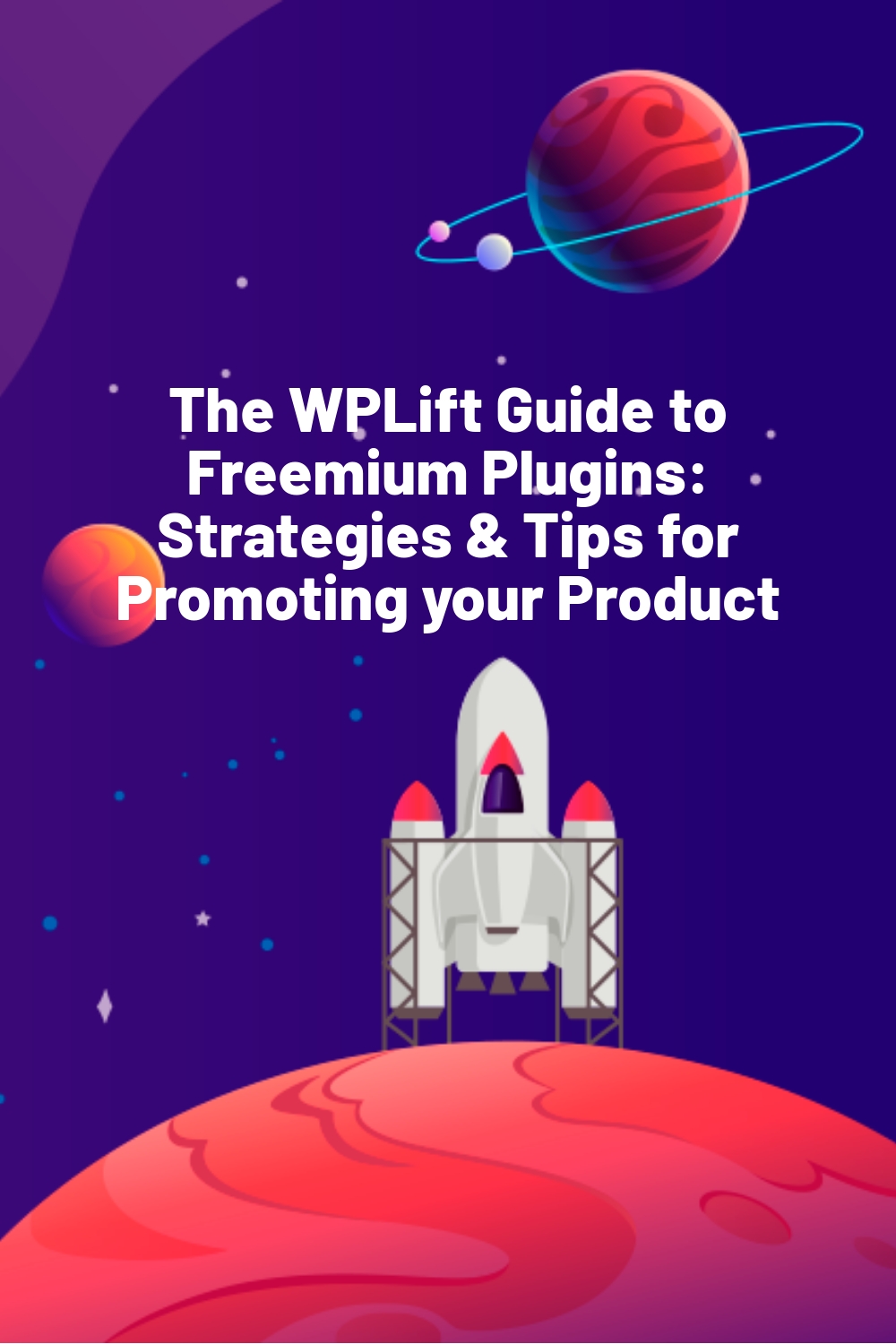WPLift is supported by its audience. When you purchase through links on our site, we may earn an affiliate commission.
The WPLift Guide to Freemium Plugins: Strategies & Tips for Promoting your Product
The popularity of the freemium model for pricing software and services is showing no signs of slowing down. WordPress plugins are just one example of how developers have succeeded in growing a business by giving away their core product for free, then making money by selling access to new features, premium support, or some other upgrade to the product or user experience.
In fact, some of the most popular WordPress plugins are freely available with additional features offered as commercial products. We highlighted 10 plugins making use of the freemium model in a recent article, but there are countless other examples out there in the WordPress ecosystem.
In this article, we will take a look at the freemium model in more detail, as well as exploring how you can go about making your freemium product a success. We’ll compare some of the different options for making use of the freemium pricing model and give you some examples and further reading.
History of the Freemium Pricing Strategy
The freemium model might seem like something unique to the digital age we now live in. A time where software can be downloaded to our phones, tablets, and computers almost instantly and often without charge. Upgrades are available at the touch of a button, simply by downloading an extension or sending our credit card details into the ether to purchase a license key
However, if you’ve been using computers for a while now and remember the days when software came on CD-ROMs and even floppy disks, you might be more familiar with this pricing strategy when it was known as shareware.
Under the shareware licensing model, the software would be given away for free on a disk, with the best features disabled or set to expire after a set period. The full version of the software could then be unlocked by purchasing the full product from your local computer store or sending a check out in the post via snail mail and then waiting for the disk to drop through the letterbox sometime later.
Freemium picked up where shareware left off and now almost any type of software, from console games, mobile apps, and of course, WordPress plugins can be successfully monetized in this way. Thanks to the upgrades in infrastructure and an increased willingness from consumers to pay online, distributing software and collecting payments have never been easier.
So if you are interested in offering your product under the freemium model or you’d just like to know a bit more about this monetization strategy, here are some tips for making your freemium product a success.

Premium vs Product Add-ons
If you do embrace the freemium model, you will need to decide whether you want to offer a free version of your plugin that can be replaced with a commercial product when the user is ready to upgrade, or you will be offering commercial add-ons. These add-ons are then installed on top of the free core plugin to add more features and functionality.

Article Continues Below

Both models have their pros and cons and both have been used with great success by many WordPress plugins. One example is the Easy Digital Downloads plugin. With this plugin, the core software is freely available with many commercial add-ons on offer for those who want to upgrade. On the other hand, an example of a plugin using the free and premium upgrade model is the popular and powerful UpdraftPlus backup plugin.
Add-on Model Considerations
Things to consider when looking at the add-on model include being able to release multiple small add-ons at your own pace, rather than creating a fully-featured premium plugin to replace the free version.
Being able to invite other developers to create add-ons for your core plugin can also help grow the appeal of the product and speed up the development process.
You might also be able to persuade more users to upgrade as the add-ons typically have a lower price tag compared to upgrading to the fully-featured premium version. However, conversely, you may earn less from the add-on model due to the lower amounts being charged.
Premium Model Considerations

When it comes to evaluating whether the premium model is the best choice for your product, some things to consider include the scale of a project required to create the fully-featured version of your product. Having a bigger product to maintain and support is something to be considered too. Furthermore, the typically larger upfront cost of purchasing the fully-featured premium product vs individual add-ons might deter some potential customers. However, it can result in more income due to the higher prices.
Furthermore, the typically larger upfront cost of purchasing the fully-featured premium product vs individual add-ons might deter some potential customers. However, it can also result in more income being generated, due to the higher prices involved.
Making use of the free and commercial model means that you can’t bring more developers on board as easily as you can with the add-on model. This, in turn, can limit the growth of your product as well as the size of the team promoting it.
Don’t Overlook the SaaS Model
There is a further option, one which OptinMonster has recently transitioned to and that is to offer your product as SaaS or Software as a Service. This is essentially a hosted version of your product rather than something the user installs directly on their website.
The SaaS model allows you to offer your product or service on a subscription-based pricing plan, collecting payment at set periods, in exchange for continued access to your product. By also introducing multiple pricing tiers, you can still provide your users with the option to upgrade from a free product to a more feature-rich commercial option.
Creating the infrastructure for delivering a SaaS can be an obstacle, however. OptinMonster was to be released as a SaaS from the outset before these plans were shelved and it was made available as a plugin. However, the benefits of going down the SaaS route can make it easier to deploy new features and appeal to a wider audience beyond just WordPress users. The SaaS model can also make it easier to restrict access to the product and collect recurring payments.
OptinMonster isn’t the only WordPress-related service to launch as a SaaS and you can find some more examples and information here.
Once you’ve chosen between offering a full premium upgrade or commercial add-ons, it’s time to start thinking about how you can promote your product. Here are some ideas.
Focus on Promoting the Free Version
The premium upgrade or the commercial add-ons for your product will generate revenue for your project. However, most of your promotional efforts should be focused on improving the visibility of the free plugin, rather than marketing your commercial add-ons and upgrades.
If you think about this, it makes perfect sense. The greater the number of people using the free core plugin, the larger your audience of potential customers is. Some users might find your commercial add-ons or the premium version of your plugin first. However, I suspect a greater number of them will be introduced to your software through the freely available version and then find out about the commercial upgrades later.
So how do you go about getting more people to install your free plugin?
Maximize Your Plugin Page

One approach is to focus on making the most of your entry in the WordPress Plugin Directory. This means ensuring you have a killer product listing.
Part of achieving this involves using this opportunity to extol the benefits of using your plugin. This includes explaining how it can help the user and why they should install it today. The old sales idiom “don’t sell the steak sell the sizzle” applies here.
So start with a good description of what the plugin has to offer in terms of how it can help the user and save the feature list for further down the page.
Other ways to ensure your listing in the WordPress Plugin Directory doesn’t let you down include:
- Add videos to the description
- Use appropriate formatting for easier reading
- Respond to user reviews, whether positive or negative
- Promptly answer tickets in the support forum
- Add content to each tab on the product listing
- Upload useful images to the screenshots section of the listing
- Populate the author profile to put a face to the name
This doesn’t just apply to plugins. Wherever your free product is listed, whether it’s in a similar directory or on your own website, you need to do all you can to present it in the best possible light. Only once you’ve built up a base of users who’ve installed your free product will you be able to sell your commercial upgrades.
Outreach and Marketing Opportunities
Once your product page is ready, it’s time to focus on getting it in front of your target audience. One popular way to achieve this is to get your product featured on a WordPress news and reviews blog, such as this one. There are countless blogs covering WordPress and its ecosystem so you really are spoilt for choice in this regard.
Many blogs offer product promotion packages. This gives you the ability to pay for coverage of your product on the blog. This can be in the form of a giveaway, a review, being featured in the newsletter, or submitting it to a website’s own plugin or another relevant directory. WP Lift offers a range of options for promoting a product, which makes it easy to get your product in front or a large number of potential users
Another option for getting coverage for your product is to approach the writers that contribute to these WordPress news and reviews blogs. There are plenty of us out there and we’re always looking for new and interesting topics to write about. By reaching out and introducing your product, you can increase your chances of it being included the next time a post is published on a topic related to your offering.
However, bloggers do get many offers from software owners to feature their products. To make your offer stand out from the crowd, it’s important to make it as easy as possible for the writer to cover your product. This means providing an easy to understand product description, a demo version to test, and as much relevant information as possible.
Setting up a media page on your website, which includes a range of screenshots and logos in various sizes, as well as other supporting material can really help a writer and make it easier for them to cover your product as opposed to a competing product.
CoSchedule is one example of a product that understands this. The freely available content, including videos, logos, screenshots, and talking points, makes it very easy for writers to promote the product.
Freemium Plugins Final Thoughts
Getting the pricing right for your product can make or break its success. This not only includes the pricing model, in terms of offering a premium upgrade vs premium add-ons, but also the price points you set for your product or service.
Product pricing is a vast topic and due to its importance in the success of your business, some further reading is highly recommended. Some resources you may want to invest in include Chris Lema’s The Price is Right book and Priceless: The Myth of Fair Value (and How to Take Advantage of It) by William Poundstone.
I hope that this introduction to pricing options for your products has given you some food for thought. If you have any more advice for our readers or questions about this topic, please share them in the comments below.








Pricing is tricky to get right.
Memberships can work if you have plenty to offer, whereas if you are just starting out, per product pricing might be better for your customers.
It looks like you’ve created some good plugins so good luck with your project.
joe